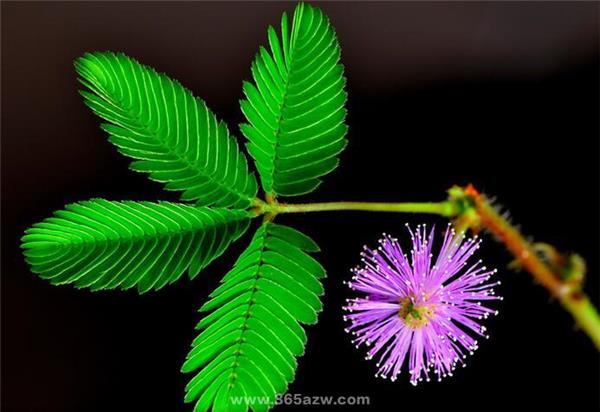How to raise mimosa how to raise mimosa
The leaves of mimosa will be folded up immediately when you touch them gently. Today, this article will recommend how to raise mimosa.

Introduction of mimosa
(scientific name: Mimosa pudica Linn.) ): it is a perennial herb or subshrub of Leguminosae. Because the leaves respond to heat and light, they close immediately when touched by external forces, so they are named mimosa. Shaped like a fluffy ball. Pods bear fruit after flowering, and the fruit is flat and round. The leaves are feathery and compound leaves are alternate and arranged in palms. Flowering about after the height of summer, heads oblong, 2-3 in leaf axils. Flowers are white, pink, calyx campanulate, with 8 tiny calyx teeth, petals quadrifid, stamens 4, ovary glabrous. The pod is flattened, with 1 seed per pod node, and the internodes fall off at maturity.
The flowers, leaves and pods of mimosa have better ornamental effect, and are easy to survive, so they are suitable for potted flowers in balcony and indoor (human consumption or excessive contact with mimosa will also cause hair loss). It can also be planted in the courtyard and other places. Mimosa is different from other plants. When touched by people, its petiole is drooping and its small leaves are closed, so people understand it as shy, so it is called inductive grass, drinking grass, mimosa, mimosa and ugly grass (Cantonese). Native to tropical South America, it likes to be warm and humid and has general requirements for soil.

Culture method of mimosa
Mimosa can be cultivated in general soil, the growth period does not need much fertilizer, dilute liquid fertilizer can be applied for 2 or 3 times, fertilizer should not be too much, leaf green can grow healthily, do not grow in vain, because mimosa is mainly interesting foliage flowers, small is better. The planting technique of mimosa is simple and the management is extensive. The requirements of climate, sunshine and soil are not strict, but the fertile, loose sandy loam is better, like the warm and humid environment.
Planting method
Generally sow and reproduce, and sow from late March to early April. Spread the seeds evenly on the fine soil and cover the soil for about 1.5m. When the temperature is about 18 ℃, the seedlings can emerge in about 10 days (generally grow in the soil, no special management is needed). It grows slowly in seedling stage and can be planted when it is 7 ~ 8 years old.
Field management. The distance between plants in the field is 25 to 30 meters, and the soil is loosened, weeded and watered in time. Indoor potted plants, watered once every 2 to 3 days in summer. Fertilize once a month, if you do not want to make the plant size too large, it is necessary to reduce the amount of fertilizer, or even do not need to apply fertilizer.

Is mimosa poisonous?
Mimosa has a small poison throughout the plant, and mimosa contains a substance called mimosa. If purification often comes into contact with mimosa, it will cause hair yellowing or even shedding. Mimosa will not cause harm to the human body during the day, but at night, mimosa can not carry out photosynthesis, it will release toxic substances. Therefore, it is recommended that mimosa had better not be put indoors, can be put on the balcony, so as not to cause harm to the body.
For mimosa, the indoor environment is not conducive to its growth. Mimosa needs strong light, and the indoor light conditions can not meet the needs of the growth of mimosa. Regular touch of mimosa is not only harmful to the human body, but also easy to cause mimosa leaves. Therefore, for the sake of their own and family health, for the healthy growth of mimosa, it is most appropriate to keep mimosa outside.
Can you raise mimosa if you have a pregnant woman at home?
Families with pregnant women had better not raise mimosa, although mimosa does not have a strong flavor, but it contains a kind of grass, this long-term contact will make the hair of the human body fall off. If there is a mimosa at home, it will lead to hair loss of pregnant women and, in severe cases, may lead to miscarriage. Raising some flowers and plants indoors will always be disadvantageous to pregnant women, not to mention pollen allergy, it will have an impact on the fetus more or less.

The above is the introduction of how to raise mimosa. I hope you can enjoy today's article.
Related
- Wuhan Hospital Iron Tree Blooming Result Was Instantly Frightened by the Gardener Master
- Which variety of camellia is the most fragrant and best? Which one do you like best?
- What is the small blue coat, the breeding methods and matters needing attention of the succulent plant
- Dormancy time and maintenance management of succulent plants during dormancy
- Minas succulent how to raise, Minas succulent plant pictures
- What are the varieties of winter succulent plants
- How to raise succulent plants in twelve rolls? let's take a look at some experience of breeding twelve rolls.
- Attention should be paid to water control for succulent plants during dormant period (winter and summer)
- Watering experience of twelve rolls of succulent plants
- Techniques for fertilizing succulent plants. An article will let you know how to fertilize succulent plants.



